This article has been
cited by other articles in ScienceCentral.
Abstract
Objectives
To appraise the effectiveness of platelet-rich fibrin (PRF) in the management of established dry socket in terms of pain, inflammation, and wound healing.
Materials and Methods
Two hundred patients with established alveolar osteitis were studied to determine the efficacy of PRF and zinc oxide eugenol (ZOE) for pain control, inflammation reduction, and wound healing. Patients were randomly allocated to Group A (PRF) or Group B (ZOE). Patients were examined on the 1st, 3rd, 7th, and 14th postoperative day and evaluated for pain using visual analogue scale scores, inflammation with a gingival index score, and wound healing through a determination of the number of bony walls exposed.
Results
Group A showed better results in terms of pain remission, control of inflammation, and wound healing compared to Group B. Results between groups were statistically significant (P<0.05).
Conclusion
PRF is a better alternative than ZOE for the effective management of alveolar osteitis.
Keywords: Dry socket, Pain, Platelet-rich fibrin, Wound healing
I. Introduction
Alveolar osteitis, also known as dry socket, is a condition that causes severe pain and impedes the normal healing process of extraction sockets. This condition usually begins 1 to 3 days after tooth extraction and is responsible for a sufferer's frequent visits to a dental hospital
1. Although first described by Crawford
2 in 1896, reports on dry socket can also be found in more contemporary literature
34. This condition was defined by Blum
5 as the presence of “postoperative pain in and around the site, which increases in severity at any time between 1 and 3 days after the extraction, accompanied by a partially or totally disintegrated blood clot within the alveolar socket, with or without halitosis.” The incidence rate of alveolar osteitis after dental extractions ranges between 1% and 30%
4, and is commonly associated with mandibular third molar extraction. The condition more commonly affects females and those over 30 years of age
678. Signs and symptoms of dry socket include severe, throbbing pain associated with an extraction socket that is devoid of a blood clot and/or contains bone exposed to the oral cavity
910 as well as foul taste in the mouth, halitosis, and edematous gingiva with local lymphadenopathy
15.
Dry socket is of great concern to dentists worldwide. Various etiologies have been described in the contemporary literature
711121314 regarding management and prevention of this condition
4151617.
Choukroun et al.
18 first developed platelet-rich fibrin (PRF), a second-generation platelet concentrate, in 2006. PRF is a fibrin matrix in which platelet cytokines, growth factors, and cells are entrapped and discharged over time and act as resorbable membrane. Unlike platelet-rich plasma (PRP), it does not require anticoagulant or bovine thrombin
1819202122. Although recent literature described the experimental use of PRP and platelet-rich growth factors in tooth extraction sockets, specific information regarding the role of PRF in the healing of the extraction socket is limited
23.
This study was undertaken to assess the potency of PRF in the management of alveolar osteitis and to compare results with those from a traditional zinc oxide eugenol (ZOE) dressing. To do so, we compared PRF (Group A) and ZOE (Group B) in terms of improving pain control, inflammation, and wound healing in cases of established dry socket. The investigators put forward a null hypothesis that no significant difference exists between groups.
II. Materials and Methods
The examiners conducted a randomized, controlled clinical trial that was approved by the Institutional Ethics and Review Board of Kothiwal Dental College and Research Centre (No. KDCRC/IERB/11/2016/35), and which followed benchmarks established by the Declaration of Helsinki. Subjects with no systemic problems, who satisfied the incorporating guidelines, were included in the study. The study population included subjects that sought assessment and management of dry socket from August 2014 to December 2017.
A total of two hundred patients representing both sexes ranging in age from 18 to 40 years were included in the study. These patients reported to the Department of Oral and Maxillofacial Surgery on the 3rd to 5th day after extraction of both maxillary and mandibular molars, and complained of severe throbbing pain that was not relieved with medication, halitosis, and had a socket devoid of clot. Exclusion criteria included females who were either pregnant or lactating and anyone with a treatment history of dry socket in the form of antibiotics, anti-inflammatory therapy, or intra-socket medications. Patients that did not provide informed consent and individuals with systemic illnesses or weakened immunity were also excluded.
A diagnostic work-up was performed for all patients, which included both a clinical examination and a radiographic presentation. Standard lab investigations were conducted for all 200 participants who provided consent for the procedure. Patient randomization occurred on the subject level using the slot method and was performed irrespective of age and sex. G*power software was used to calculate sample size, a 5% level of precision, 95% confidence level and 80% power of the study. A digitally produced random number was arranged by a specialist with no clinical contribution to the trial. All subjects were numbered from 1 to 200, assigned an order number (using the random number list) and treated during scheduled appointments on the following visit. All participants were randomly allocated to Group A (100 patients for PRF) or Group B (100 patients for ZOE).
To reduce study bias, a single oral surgeon performed all procedures under local anesthesia using standard aseptic provisions and protocols. All patients in the study were routinely orally administered Tab. diclofenac 50 mg and Tab. paracetamol 325 mg as rescue medication.
1. Primary outcome variables
Different parameters were utilized to evaluate the examination subjects.(
Tables 1,
2)
1) Pain: Pain was estimated using a 10 point visual analogue scale (VAS). Baseline pain measurements were recorded prior to the procedure and subsequently on the 1st, 3rd, 7th, and 14th day after the procedure.
2) Degree of inflammation: Inflammation was determined clinically by the presence or absence of bleeding on probing of the gingival tissue surrounding the dry socket at the baseline level and on the 1st, 3rd, 7th, and 14th postoperative day using a gingival severity index.
3) Granulation tissue formation: Granulation tissue is a specialized tissue that is a hallmark of wound healing. Its formation is obvious clinically by the covering of the denuded bony socket wall by delicate granulation tissue. Tissue quality and texture were assessed by the presence and absence of bleeding on the 1st, 3rd, 7th, and 14th postoperative day.
The PRF was prepared as per the convention of Choukroun et al.
18.
Extraction sockets of all patients from Groups A and B were irrigated with a mixture of isotonic saline and povidone iodine solution to remove blood clots and debris. Patients in Group A had PRF grafted over dry sockets and patients in Group B had dry sockets packed with ZOE. Postoperative instructions were provided and patients were recalled for a follow-up examination on the 1st, 3rd, 7th and 14th day post-surgery.
2. Statistical analysis
To determine if significant differences in pain control, inflammation, and wound healing existed between groups, a null hypothesis was established which states that there is no significant difference exists among both the groups (i.e., µ1 is equal to µ2). Similarly, an alternate hypothesis was proposed which states that there is a significant differences exists between both the groups i.e. PRF is better than ZOE.
To test the null hypothesis, data was analyzed using IBM SPSS Statistics (ver. 21.0; IBM Corp., Armonk, NY, USA). Clinical parameters and outcomes were assessed by two researchers in a blind study. A Shapiro-Wilk test was conducted to check all variables for normality because the number of bony walls exposed and the scores of the visual analog scale (assessment of pain) are taken as normal data; therefore parametric tests including repeated measures ANOVA and independent t-test were performed. Non-parametric tests (i.e., Friedman's test and Mann-Whitney U test) were used to assess degree of inflammation. Statistical significance was established at P<0.05.
III. Results
Although this study was performed using a sample size of two hundred patients (100 per group), five participants from each group dropped out; therefore, final results were compiled for 190 patients (i.e., 95 from each group).(
Fig. 1)
Group A was comprised of 38.9% (n=37) male and 61.1% (n=58) female patients, whereas Group B was comprised of 42.1% (n=40) male and 57.9% (n=55) female patients. Incidence of dry socket was more common in females. Patient ages ranged from 18 to 40 years (mean, 32 years). Incidence of dry socket was significantly more common in the mandible compared to the maxilla in both groups (P=0.003).
Groups A and B had mean pain values of 4.57 and 6.15, respectively, on the 1st postoperative day. However, mean pain values on the 3rd, 7th, and 14th postoperative days were significantly different between groups (
P<0.001). The mean pain scores for Group A were 2.38, 0, and 0 whereas the mean pain scores for Group B were 3.85, 1.70, and 1.20 on the 3rd, 7th, and 14th postoperative days, respectively. While patients from both groups measured severe pain on a VAS on postoperative day 1, there were significant differences in mean pain scores between groups for all postoperative examinations, with Group A showing faster and better pain remission.(
Table 3,
Fig. 2)
No patients in Group A required rescue medication for pain during the follow-up period; however, all patients in Group B needed rescue medication for pain control. These results were statistically significant (
P<0.05).(
Table 4)
An assessment of inflammation was performed on the 1st, 3rd, 7th, and 14th postoperative day. The mean value of inflammation on postoperative day 1 was 96.9 for Group A and 104.1 for Group B.
Mean values of inflammation on the 3rd, 7th, and 14th postoperative day were significantly different between groups (
P<0.001). Mean scores for Group A were 91.5, 82.5, and 35.6 and mean scores for Group B were 109.5, 118.5, and 68.7 for the 3rd, 7th, and 14th postoperative day.(
Table 3,
Fig. 3)
Stripped bony socket walls, noticeable before the placement of PRF in the extraction sockets and at the 1st postoperative day, were replaced by healthy granulation tissue. The mean number of exposed walls in patients from Groups A and B on postoperative day 1 was 2.62 and 3.02, respectively. On the 3rd, 7th, and 14th postoperative day, means were 1.60, 0.60, and 0.20 for Group A and 1.97, 0.83, and 0.55 for Group B. These results suggest that by the end of two weeks, no bony walls were exposed in any extraction sites in group A, opposed to patients in group B (
P<0.05).(
Table 3,
Fig. 4)
IV. Discussion
The principal motivation behind this study was to compare the impacts of PRF to a more traditional method of treatment (ZOE dressing) in established dry socket cases in terms of pain remission, inflammation control, and granulation tissue formation. Results from this study confirmed the alternate hypothesis that there was a significant difference between Groups A and B, with the PRF group showing significantly better pain control, inflammation, and wound healing (P<0.05). Based on these results, the use of PRF in the treatment of established dry socket cases is warranted as it decreases the number of patient visits to the dental office, which is more convenient and economical.
This study was conducted in order to establish a treatment option for alveolar osteitis. The cause of dry socket is believed to be multifactorial, and satisfactory explanations of its causes were provided by Birn
6 and Nitzan
13. The contributions of
Actinomyces viscosus and
Treponema denticola to dry socket have been reported in previous studies
1113, leading to the extended use of antibiotic mouthwashes, intra-socket medicaments and various pharmacological agents
415, mostly in vain.
This study showed that females are more prone to dry socket compared to men, perhaps due to use of oral contraceptives, menstruation, and in accordance with other studies by Xu et al.
14 and Eshghpour et al.
24.
We found that dry socket is more common in the mandible than in the maxilla and may be due to a more difficult and traumatic mandibular extraction that leads to bone marrow inflammation and discharge of direct tissue activators
8.
Results from our study revealed a gradual remission in pain in terms of VAS scores among patients from both groups over time. This reduction in pain intensity was greater in patients treated with PRF compared with those treated with ZOE, and can be attributed to immune regulation by PRF and a subsequent decrease in inflammation. It implies that the fibrin matrix aids in angiogenesis and reduces the inflammation process by encasing the exposed nerve endings in the socket and results in a notable decrease in pain
21. Eshghpour et al.
24 reported a marked reduction in inflammation associated with the use of PRF and hypothesized that PRF has immune regulatory action and can invigorate defense mechanisms to arrest infections
23.
Similarly, in our study there was a progressive reduction in inflammation in patients treated with PRF compared to those treated with ZOE. Previous studies have shown that packing the extraction socket with ZOE could lead to delayed socket healing and risk of infection due to localized irritation
25. Our study showed that patients treated with PRF exhibited better socket healing than those treated with ZOE in terms of granulation tissue formation around the empty socket walls on the 14th postoperative day. PRF may have the innate property of delivering growth factors in a controlled manner, which invokes a mitogenic response essential for bone repair during normal wound healing
18.
A main strength of this study was the large sample size combined with adequate patient follow-up. Although management of alveolar osteitis with PRF was an invasive and tedious procedure, it provided good pain control, was more economical with less patient visits, and resulted in better wound healing. However, multi-centric trials are required prior to its inclusion in the armamentarium of oral surgeons and dentists.
V. Conclusion
The event of dry socket in a regular oral surgical procedure or dental practice is inevitable. The risk factors related with it should be examined prior to the procedure. Albeit different strategies for anticipation of dry socket have been utilized, the administration of set-up is a constrained and troublesome case. With PRF picking up grounds as an intense wound healer, the present study concentrated on dealing with the troublesome pain and delayed wound healing related with dry socket with this autologous material. Critical decline in pain level was noted by the utilization of PRF, and better wound healing was advocated.
Fig. 1
Flow diagram for patient recruitment and selection. (PRF: platelet-rich fibrin, ZOE: zinc oxide eugenol)
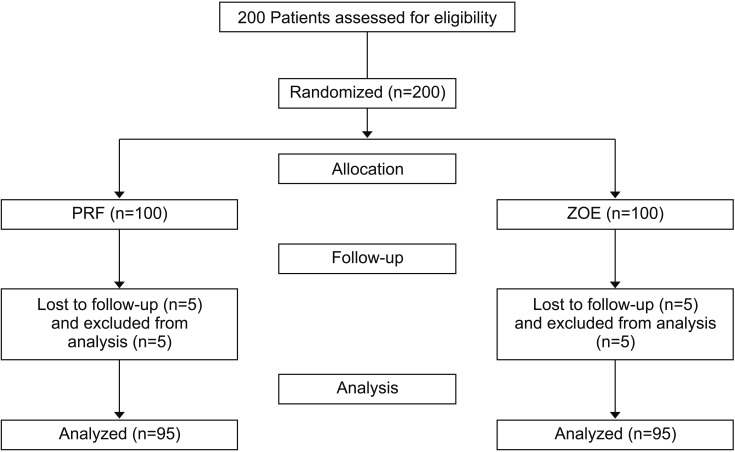
Fig. 2
Visual analogue scale (VAS) for pain at 1st, 3rd, 7th, and 14th day. Values are presented as mean. (Group A: platelet-rich fibrin, Group B: zinc oxide eugenol)
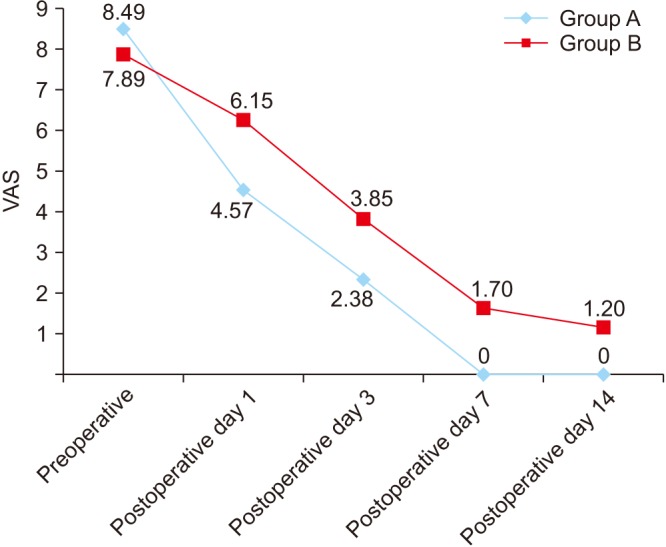
Fig. 3
Presence or absence of inflammation on 1st, 3rd, 7th, and 14th day. Values are presented as mean. (Group A: platelet-rich fibrin, Group B: zinc oxide eugenol)
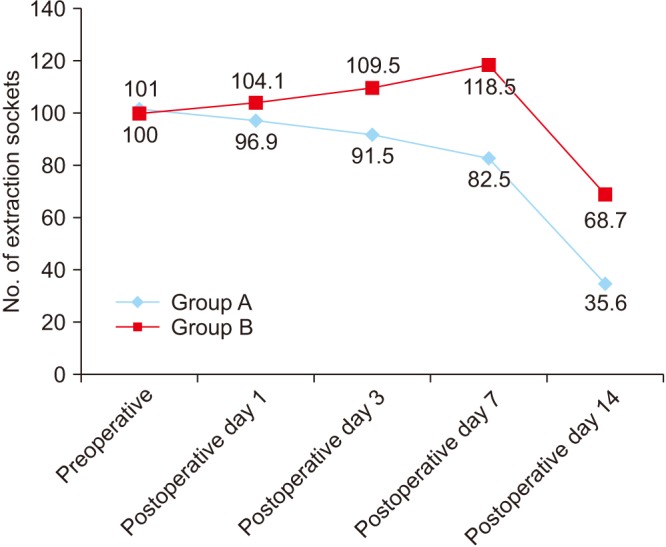
Fig. 4
Assessment of bone healing through number of exposed walls on 1st, 3rd, 7th, and 14th day. Values are presented as mean. (Group A: platelet-rich fibrin, Group B: zinc oxide eugenol)
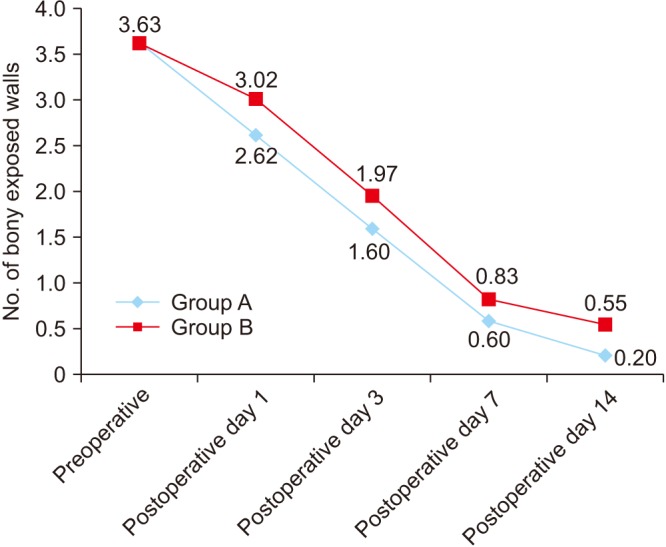
Table 1
Preoperative evaluation criteria
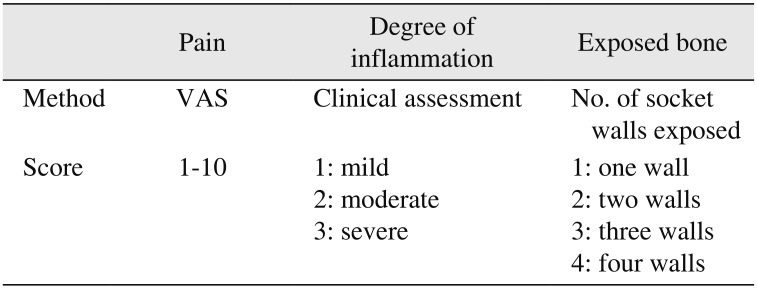
|
Pain |
Degree of inflammation |
Exposed bone |
|
Method |
VAS |
Clinical assessment |
No. of socket walls exposed |
|
Score |
1-10 |
1: mild |
1: one wall |
|
|
2: moderate |
2: two walls |
|
|
3: severe |
3: three walls |
|
|
|
4: four walls |
Table 2
Postoperative evaluation criteria
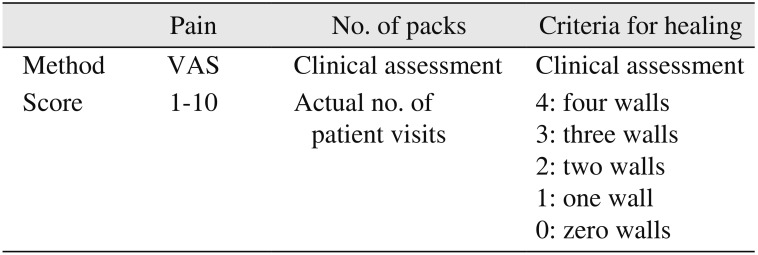
|
Pain |
No. of packs |
Criteria for healing |
|
Method |
VAS |
Clinical assessment |
Clinical assessment |
|
Score |
1-10 |
Actual no. of patient visits |
4: four walls |
|
|
|
3: three walls |
|
|
|
2: two walls |
|
|
|
1: one wall |
|
|
|
0: zero walls |
Table 3
Primary outcome variables

|
Postoperative day |
Pain |
Inflammation |
Exposed bone |
|
Group A |
Group B |
P-value |
Group A |
Group B |
P-value |
Group A |
Group B |
P-value |
|
1st |
4.57 |
6.15 |
<0.001*
|
96.9 |
104.1 |
0.450 |
2.62 |
3.02 |
<0.001*
|
|
3rd |
2.38 |
3.85 |
<0.001*
|
91.5 |
109.5 |
<0.001*
|
1.60 |
1.97 |
<0.001*
|
|
7th |
0 |
1.70 |
<0.001*
|
82.5 |
0118.5 |
<0.001*
|
0.60 |
0.83 |
<0.001*
|
|
14th |
0 |
1.20 |
<0.001*
|
35.6 |
68.7 |
<0.001*
|
0.20 |
0.55 |
<0.001*
|
Table 4
Secondary outcome variables
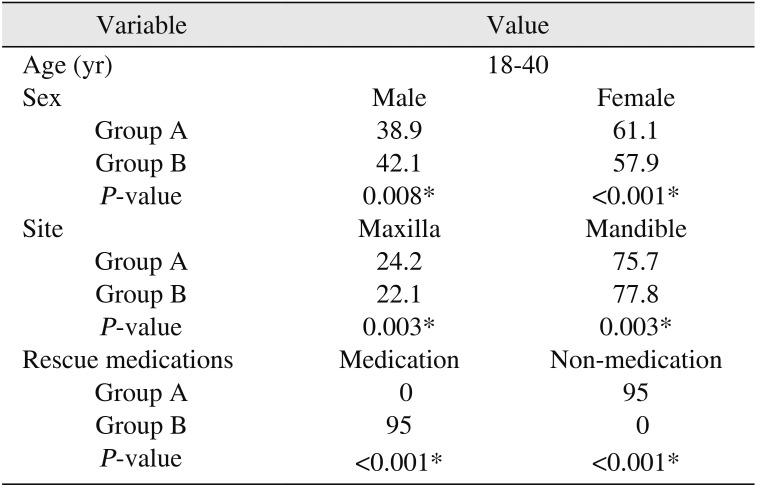
|
Variable |
Value |
|
Age (yr) |
18-40 |
|
Sex |
|
Male |
Female |
|
Group A |
38.9 |
61.1 |
|
Group B |
42.1 |
57.9 |
|
P-value |
0.008*
|
<0.001*
|
|
Site |
|
Maxilla |
Mandible |
|
Group A |
24.2 |
75.7 |
|
Group B |
22.1 |
77.8 |
|
P-value |
0.003*
|
0.003*
|
|
Rescue medications |
|
Medication |
Non-medication |
|
Group A |
0 |
95 |
|
Group B |
95 |
0 |
|
P-value |
<0.001*
|
<0.001*
|












